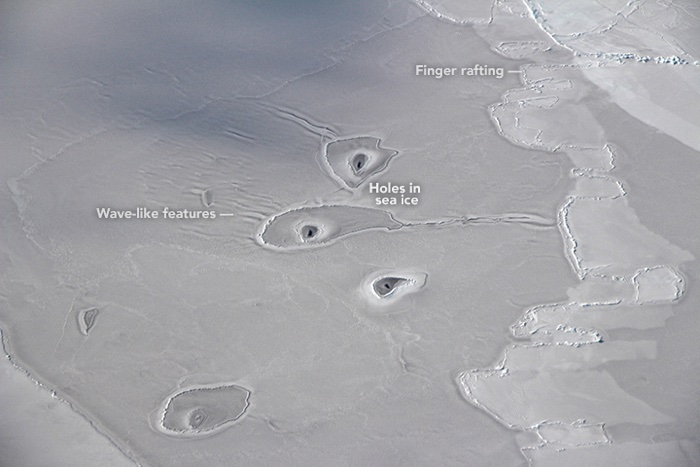NASA has been running aerial surveys over the Arctic for 10 years now, but the vast icy wilderness is still throwing up inexplicable surprises nobody's ever seen before.
Case in point: just what are these weird circular formations spotted from a P–3 research plane flying over the Beaufort Sea last week?
The image above and below was captured by cryospheric scientist John Sonntag, who heads up NASA's Operation IceBridge, which charts sea ice levels and behaviour at both of Earth's polar regions.
You might not know Sonntag's name, but you've almost definitely seen his photographic portfolio before, as his day job sees him aerially documenting the wintry, white vistas that define the world's evolving Arctic and Antarctic landscapes.
Sonntag's held this unique gig for a while now, but even he still gets a curveball now and then – like with these mysterious holes he first glimpsed two Saturdays ago, about 80 kilometres (50 miles) northwest of Canada's Mackenzie River Delta.
"We saw these sorta-circular features only for a few minutes today," Sonntag wrote from the field.
"I don't recall seeing this sort of thing elsewhere."
The holes, spotted while charting sea ice levels along the eastern Beaufort Sea, are as yet unexplained, but there are a few things researchers are speculating they might be.
First up, there are a couple of signs that indicate we're looking at relatively young ice here, which is newly formed over a previously open body of water.
"The ice is likely thin, soft, and mushy and somewhat pliable," says sea ice geophysicist Don Perovich from Dartmouth College in the UK.
"This can be seen in the wave-like features in front of the middle 'amoeba'."
Another tell-tale sign is the 'finger rafting' on the right-hand side of the image, which suggests what could be a general left-to-right motion of the ice.
This kind of distinctive zig-zag patterning occurs when two layers of ice collide with one another, forming finger-like protrusions on the surface as the two sheets are forced to splice together.
 (John Sonntag/Operation IceBridge)
(John Sonntag/Operation IceBridge)
"It's definitely an area of thin ice, as you can see finger rafting near the holes and the colour is grey enough to indicate little snow cover," says IceBridge project scientist Nathan Kurtz, explaining the ice landscape surrounding the holes.
As for the holes and circles themselves, though, Kurtz is also uncertain.
"I'm not sure what kind of dynamics could lead to the semi-circle shaped features surrounding the holes," he says. "I have never seen anything like that before."
One idea is they could have some kind of animal origin. For example, seals gnaw breathing holes into ice, which give them a clear space to come up and surface within the otherwise unbroken ice floes.
If that's the case, it's possible the larger circles that surround the holes come from the behaviour of the seals, forming freezing puddles as the animals emerge from their frigid dip.
"The encircling features may be due to waves of water washing out over the snow and ice when the seals surface," explains oceanographer and climate scientist Walt Meier from the National Snow and Ice Data Centre.
"Or it could be a sort of drainage feature that results from when the hole is made in the ice."
If the phenomenon isn't caused by seals or other animals – and discounting any tantalising conjecture of extra-terrestrials dabbling in the ice – deduction suggests it's some kind of naturally occurring weather phenomenon we just haven't had a chance to study up close yet.
"This is in pretty shallow water generally, so there is every chance this is just 'warm springs' or seeps of ground water flowing from the mountains inland that make their presence known in this particular area," explains NASA glaciologist Chris Shuman from the University of Maryland at Baltimore County.
"The other possibility is that warmer water from Beaufort currents or out of the Mackenzie River is finding its way to the surface due to interacting with the bathymetry, just the way some polynyas form."
Polynyas are areas of open water surrounded by sea ice – which in strong wind conditions behave like outdoor 'ice factories', producing as much as 10 times more sea ice than usual – including exotic, rare forms of ice that almost seem magically inspired.
While we may not have a confirmed explanation for the latest evidence of this kind of phenomena, you can bet it's something that's captured the attention of scientists, and sooner or later we'll get a more thorough understanding of just what the heck is going on here.
Read Again Even NASA Isn't Sure What's Making These Bizarre Circles in The Arctic : https://ift.tt/2HQE069Bagikan Berita Ini















0 Response to "Even NASA Isn't Sure What's Making These Bizarre Circles in The Arctic"
Post a Comment